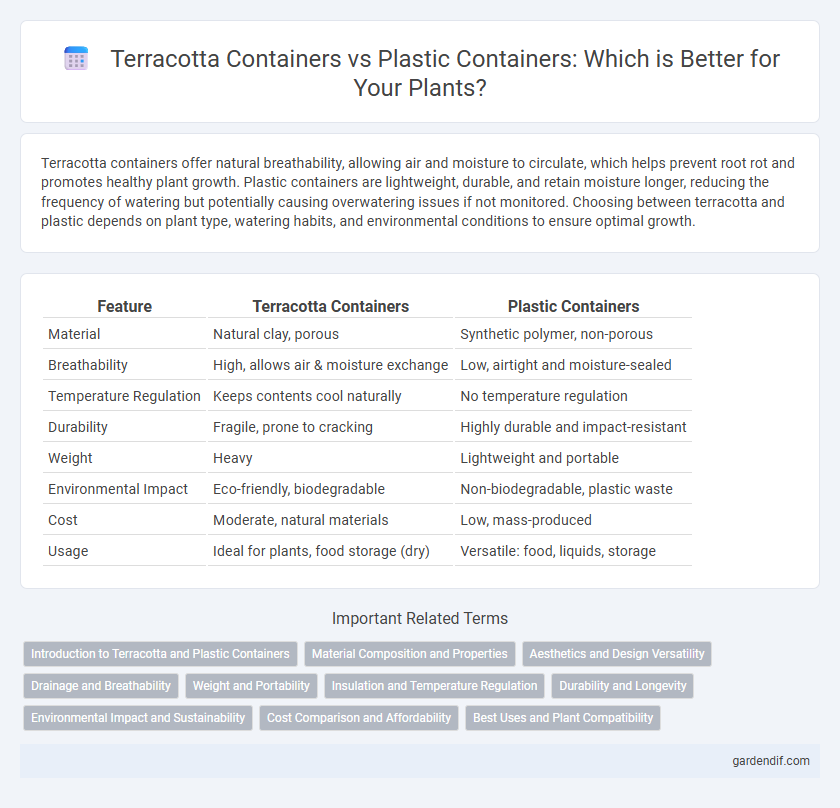
Terracotta containers vs plastic containers Illustration
Terracotta containers offer natural breathability, allowing air and moisture to circulate, which helps prevent root rot and promotes healthy plant growth. Plastic containers are lightweight, durable, and retain moisture longer, reducing the frequency of watering but potentially causing overwatering issues if not monitored. Choosing between terracotta and plastic depends on plant type, watering habits, and environmental conditions to ensure optimal growth.
Table of Comparison
| Feature | Terracotta Containers | Plastic Containers |
|---|---|---|
| Material | Natural clay, porous | Synthetic polymer, non-porous |
| Breathability | High, allows air & moisture exchange | Low, airtight and moisture-sealed |
| Temperature Regulation | Keeps contents cool naturally | No temperature regulation |
| Durability | Fragile, prone to cracking | Highly durable and impact-resistant |
| Weight | Heavy | Lightweight and portable |
| Environmental Impact | Eco-friendly, biodegradable | Non-biodegradable, plastic waste |
| Cost | Moderate, natural materials | Low, mass-produced |
| Usage | Ideal for plants, food storage (dry) | Versatile: food, liquids, storage |
Introduction to Terracotta and Plastic Containers
Terracotta containers are made from natural clay, providing excellent breathability and moisture regulation for plant roots, which helps prevent overwatering and root rot. Plastic containers, composed of durable synthetic materials, offer lightweight, inexpensive options with high resistance to weathering and breakage but lack the natural aeration properties of terracotta. Choosing between terracotta and plastic containers depends on the specific needs of the plants, environmental conditions, and aesthetic preferences.
Material Composition and Properties
Terracotta containers are made from natural clay that is porous and breathable, allowing air and moisture exchange which benefits plant root health and prevents waterlogging. In contrast, plastic containers consist of synthetic polymers like polyethylene or polypropylene, making them lightweight, non-porous, and moisture-retentive but less breathable. Terracotta's material composition provides natural insulation and temperature regulation, whereas plastic's durability and resistance to cracking under extreme temperatures offer practical advantages for long-term use.
Aesthetics and Design Versatility
Terracotta containers offer a natural, rustic aesthetic that enhances garden and home decor with their earthy tones and textured surfaces. They are highly versatile in design, available in various shapes and sizes that complement traditional and modern styles alike. Plastic containers, while available in diverse colors and forms, often lack the organic appeal and tactile quality that terracotta provides, making terracotta preferred for aesthetic-focused plant displays.
Drainage and Breathability
Terracotta containers offer superior drainage due to their porous nature, allowing excess water to escape easily and preventing root rot. Their breathability facilitates better air circulation to plant roots, enhancing oxygen availability and promoting healthier root growth. In contrast, plastic containers often retain moisture and limit airflow, increasing the risk of overwatering and poor root development.
Weight and Portability
Terracotta containers are significantly heavier than plastic containers, which affects their portability and ease of handling. Plastic containers offer lightweight construction, making them ideal for frequent movement and transport. The weight difference directly influences user convenience, especially in gardening or storage scenarios requiring regular repositioning.
Insulation and Temperature Regulation
Terracotta containers offer superior natural insulation due to their porous structure, which allows air and moisture to circulate, maintaining a cooler and more stable temperature for plant roots. Unlike plastic containers, which can trap heat and cause temperature fluctuations, terracotta reduces heat stress by promoting evaporative cooling. This temperature regulation enhances plant health by preventing overheating and providing a consistent growing environment.
Durability and Longevity
Terracotta containers offer superior durability due to their thick, porous structure, which resists cracking and withstands temperature fluctuations better than plastic containers. Unlike plastic, which can degrade and become brittle from prolonged UV exposure, terracotta maintains its structural integrity over many years. The natural breathability of terracotta also prevents soil overwatering issues, contributing to longer plant health and container lifespan.
Environmental Impact and Sustainability
Terracotta containers offer superior environmental benefits compared to plastic containers due to their natural, biodegradable composition and minimal production energy requirements. Unlike plastic, terracotta does not release harmful microplastics into the soil or water, ensuring a healthier ecosystem. Sustainable terracotta manufacturing uses abundant clay resources and supports local artisans, reducing carbon footprints linked to synthetic plastic production and disposal.
Cost Comparison and Affordability
Terracotta containers generally have a higher upfront cost compared to plastic containers but offer greater durability and a natural aesthetic that can justify the investment for long-term use. Plastic containers are usually more affordable initially, making them a budget-friendly option for large-scale or temporary gardening needs. When considering cost-effectiveness, terracotta is more economical over time due to its longevity and minimal replacement frequency.
Best Uses and Plant Compatibility
Terracotta containers offer excellent breathability, making them ideal for succulents, cacti, and Mediterranean herbs that thrive in well-drained soil and drier conditions. Plastic containers retain moisture longer, benefiting moisture-loving plants such as ferns, tropicals, and vegetables that require consistent hydration. Choosing between terracotta and plastic depends on the plant's water needs and root aeration preferences for optimal growth.
Terracotta containers vs plastic containers Infographic

 gardendif.com
gardendif.com